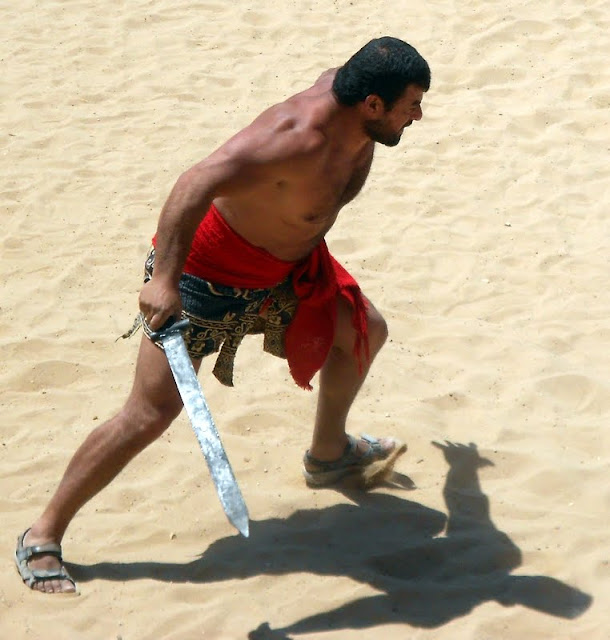Our first day, and a hot one. It had been our intention to drive further north after Jerash to Umm Qais, another Roman remain and from which you can look across at the Golan Heights and the Sea of Galilee, but we under-estimated the distance and time involved and so had to change our plans.
It's a lovely drive toJerash, once you've survived the intersection at the 8th Circle, through beautiful countryside lush with eucalyptus and olive trees. Being the Middle East, however, the Real World is never far away, the road taking us past Baqaa, the biggest of Jordan's UN-run Palestinian refugee camps (today a city of 100,000 plus).
Archaeological evidence shows the Jerash area to have been settled since around 1600 BC. The city itself (named Gerasa) was founded by the Greeks around 170 BC, and 'liberated' and granted autonomy by the Romans under Pompey in 63 BC. It was in the century after this that the basic town plan as it survives today was laid down.
Hadrian's Arch
This is the first monument we saw as we approached Jerash from Amman, an 11-metre high triple-arched gateway which originally stood to almost 22m. It was built in 129 - 131 AD to honour the visit of the Emperor Hadrian. Being sited over 400m. from the city walls, it was presumably expected to be a great city gate that was to be the entrance to a planned, but never built, vastly-expanded city.
The Hippodrome
This array of small arches belongs to the reconstructed south wall of the Hippodrome, the scene of ancient Gerasa's sporting festivals and chariot races. 244m. long, and seating 15,000 spectators, it is the smallest hippodrome so far discovered in the Roman Empire. ( The Circus Maximus in Rome could seat 157,000.)
RACE reenactments.
- Chariot Racing.
A company called RACE (Roman Army and Chariots Experience) stages in the Jerash Hippodrome reenactments of chariot races and displays of Roman military prowess. Based on extensive research, shows take place twice daily, all the costumes and equipment being made locally and everyone involved in the show being from Jerash.
 |
| We sat where the original spectators would have been sitting. |
The Hollywood image of chariot racing, as shown in 'Ben Hur' and other films, is of gleaming, armour-plated war chariots, but in reality the Romans used chariots only for racing, not in battle, building fifty-kilogram wicker-work chariots, drawn by two horses.
2. Roman Legions and Gladiators.
Other Sights in Jerash
Our visit coincided with the arrival of numerous groups of Jordanian school children, all female. (We couldn't figure out whether teenage boys were not taken there or whether there was a policy of segregating the sexes during visits.) We proved to be a greater attraction to many of the girls than the site they had been taken to, following us around and constantly wanting us to take pictures of them with us! And, did they make a lot of noise!!



























No comments:
Post a Comment